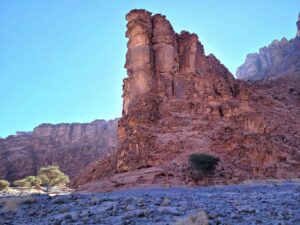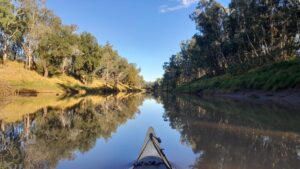Over the last 12 months, ExplorersWeb has documented incredible adventures in climbing, cycling, running, walking, skiing and anything involving force of will and dedication to a dream in the outdoors. As this year comes to a close, we present our countdown of the Top 10 Expeditions of 2021.
Neal Moore’s colossal canoe odyssey across America is number nine in our annual top 10 expeditions, but it’s my personal favorite. In an adventure world dominated by ego, repeat climbs, fastest known times, and finicky classifiers, Moore’s journey harks back to a simpler time. That is a painfully cliché turn of phrase, but this project placed the experience front and center. Moore wanted to see America, to document a changing country in the run-up to the most polarized national election in U.S. history, and to see if his “crazy route from coast to coast” could be continuous.
Through a changing America
Moore set off on February 9, 2020, when the world was a very different place. Soon after, COVID ripped through the country and largely scuppered his slow journalism plans.
Though Moore spent more time alone than expected, he found ways to document those he met along the way. He painted a picture of a country adapting to COVID and a new political reality. Somehow, he seems to have maintained a level of positivity that I find admirable, and incapable of matching.
“I’ve found that folks from all political persuasions appreciate the idea to look for what binds us together as Americans as opposed to what tears us apart. And this is what I’m truly on the lookout for. To highlight, to underscore, to celebrate,” he told me from the Ohio River back in August.

The wreckage of the towboat Clare Beatty lies partially submerged in the Ohio River. Photo: Neal Moore
He was barely out of Oregon when it officially closed down for COVID. By the time he reached eastern Washington, there was a state-wide stay-at-home order, and the U.S.-Canada border closed. But Moore found ways to continue. Instead of progressing along the Columbia River in Washington, he took the Snake River into Idaho
“What stood out was both the ruggedness and remoteness of the Snake River. In the nine days I paddled her, I didn’t see any other boats, and not one fisherman. I experienced sleet, snow, a torrent of rain, and wind pushing me forward, backward, and side to side,” he said after.
His route took in a huge swathe of America. Starting on the Pacific coast, he meandered his way inland, through Montana and North Dakota. Then he headed south, from waterway to waterway he paddled and portaged to the Gulf of Mexico. Next, it was a long journey back north, all the way to the Great Lakes. Finally, he turned east to paddle into New York. His route formed a giant oxbow bend across America’s heartland states and covered a whopping 12,000km.

Moore’s massive 12,000km route. Photo: Neal Moore
Wind, waves, and close shaves
Expeditions on this scale are big commitments, physically and mentally. Ensuring his crossing was continuous seems to have fueled Moore, but he was conscious of all the variables that were out of his control.
“It has a chance to be continuous if my strength, mental state, bodily health, and the flooding, derechos [windstorms], twisters, and COVID — all the Acts of God that the natural environment might hurl my way — don’t derail me,” he explained, with thousands of kilometres still ahead of him. And inevitably, there was no shortage of hazards.
Moore narrowly avoided bailing on the Snake River and had a close shave with a tow-boat on the Mississippi. But it was on the Washington side of the Colombia River that he came closest to disaster.
“The waves pushing upriver chop into you unlike any other place I have paddled, propelling the craft quickly forward as you watch for obstacles — boulders, submerged trees, anything that can capsize you. I managed to get into a cove an hour later, sitting on the slippery, jagged boulders as I held onto the canoe. The canoe was smashing up and down onto the rocks with each progressively larger wave, and if I didn’t get it out, it would be destroyed.”

It looks deceptively serene, but Moore found himself trapped in a small cove attempting to protect his canoe from damage. Photo: Neal Moore
The gale didn’t abate, and as waves swamped his canoe, Moore called for help. The Corp of Engineers sent out a couple of young rangers, but their rescue boat’s motor gave out. After a dozen nervy minutes at the mercy of the wind and rocks, the motor finally restarted and they made it to safety.
Something different
Moore’s journey feels authentic in a way that many expeditions do not. His Instagram feed is not swamped with glossy photos that have been edited beyond reality; this looks like America, warts and all.

The subject of the film Dark Waters, the Washington Works Plant, reflects off the Ohio River at midnight. Near Parkersburg, West Virginia. Photo: Neal Moore
This feeling of authenticity may also stem from something of an illusion. Moore’s journey feels relatable in a way that Killian Jornet running up Everest does not. As a basketball fan (and very casual player), it’s something like watching Steph Curry versus LeBron James. LeBron is so obviously super-human athletically that it’s like watching a different sport to the one I play. Curry, who appears small, skinny, and bound by the laws of gravity, feels relatable, replicable even.
But it’s largely an illusion. If Curry’s brilliance were attainable there would be more than one Steph Curry. Similarly, the familiarity of Moore’s journey, through places many of us know, can obscure the immensity, difficulty, and commitment required.
Riding 22 rivers, in 22 states, for 22 tumultuous months, Moore’s odyssey defies easy categorization. It’s not necessarily a sporting achievement, it’s not traditionally what we’d think of as exploration either. It’s a true one-off, a unique journey by a unique man, during a unique time.






